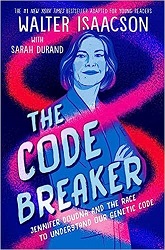Jennifer Doudna and the Race to Understand Our Genetic Code
by Walter Isaacson
with Sarah Durand
Simon & Schuster Books for Young Readers, 2022. Adapted from The Code Breaker, by Walter Isaacson, 2021. 320 pages.
Review written January 8, 2023, from a library book
Starred Review
This is the young readers’ adaptation of the book for adults by Walter Isaacson. Honestly, I had trouble with the density of this book, so I’m glad I read the young adult version! This was much slower reading than a typical young adult novel, and was packed with details and facts.
But despite the density, this is fascinating reading. The introduction begins with a story of a woman cured of sickle-cell anemia with gene therapy. Then they talk about some other possibilities of these techniques that came from breaking the human genetic code — learning how DNA and RNA work.
The book is the story of the career of Jennifer Doudna, who ended up being a pioneer in the field of gene-editing research and technology. But her story goes much deeper than simply one woman’s accomplishments. This is a section from the introduction:
Doudna’s life offers an up-close look at how science works. Her story helps answer: What actually happens in a lab? To what extent do discoveries depend on individual genius, and how has teamwork become more critical? And has the competition for individual prizes, money, and fame stopped people from working together for the common good?
Most of all, Doudna’s story conveys the importance of basic science, meaning quests that are curiosity-driven rather than geared toward immediate, practical results. Curiosity-driven research plants the seeds — sometimes in unpredictable ways — for later discoveries. For example, a few scientists decided to research basic physics simply because it excited them, and their discoveries eventually led to the invention of the microchip. Similarly, the findings of a handful of researchers who took an interest in an astonishing method that bacteria use to fight off viruses helped generate a revolutionary gene-editing tool that humans now use in their own struggle against viruses.
Jennifer Doudna is the perfect example of that brand of curiosity. Hers is a tale filled with the biggest of questions, from the origins of the universe to the future of the human race. Yet it begins with a sixth-grade girl who loved searching for “sleeping grass” and other fascinating phenomena amid the lava rocks of Hawaii, and who came home from school one day to find on her bed a detective tale about the people who discovered what they believed to be “the secret of life.”
The story in this book is very immediate, with the entire last section talking about using CRISPR technology to detect and fight coronaviruses.
I think it’s especially apt to adapt this book for young adults, since this technology will be something they’re growing up with. The entire last half of the book raises questions about ethics and the morality of editing the genes of humans and possibly our descendants. As more and more becomes possible, it is good to bring to young people’s attention the need to think about ethical concerns.
The science in this book is fascinating, and might end up being something very much a part of young people’s lives. I can’t say that it gave me a new understanding of gene editing, because saying I understand it would be exaggerating. But it at least gave me a new appreciation.
Find this review on Sonderbooks at: www.sonderbooks.com/Teen_Nonfiction/code_breaker.html
Disclosure: I am an Amazon Affiliate, and will earn a small percentage if you order a book on Amazon after clicking through from my site.
Disclaimer: I am a professional librarian, but the views expressed are solely my own, and in no way represent the official views of my employer or of any committee or group of which I am part.
What did you think of this book?
